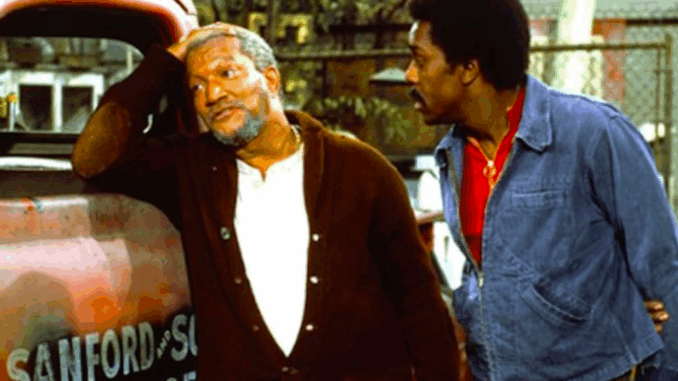
When Sanford and Son premiered on NBC in January 1972, no one could have predicted just how deeply it would reshape American television. On the surface, the show was a simple sitcom about a cantankerous junk dealer and his long-suffering son. But beneath its fast-talking one-liners, slapstick arguments, and junkyard setting, Sanford and Son was a revolutionary show—one that opened doors, challenged stereotypes, and offered audiences something they hadn’t seen before: a working-class Black family at the center of mainstream
More than fifty years later, Sanford and Son remains not just beloved, but important. And its impact continues to echo through every sitcom that followed.
Fred Sanford: A Loudmouth with Layers
Fred G. Sanford, played to perfection by Redd Foxx, is now legendary: a sharp-tongued, scheming, self-described “old Black man” who proudly ran his junk business in Watts, Los Angeles. But Fred wasn’t just comic relief—he was a nuanced portrait of a generation.
He could be petty and grumpy, yes, but also vulnerable, tender, and smart. His catchphrases—”You big dummy!” and “This is the big one!”—have become part of the American lexicon. But what made him special was that he was allowed to be fully human.
Fred wasn’t just a dad or a side character. He was the lead. And that changed everything.
A Father-Son Relationship Unlike Any Other
While Fred got the laughs, Lamont (played by Demond Wilson) brought the heart. Their relationship was central to the show’s emotional rhythm. Lamont wanted more out of life than the junk business. He wanted upward mobility, respect, and peace. Fred, meanwhile, wanted to keep Lamont close—and was often threatened by the younger man’s independence.
The show didn’t shy away from generational tensions, pride, disappointment, or deep affection. Some episodes leaned into broad comedy. Others had real pathos, showing a kind of emotional depth that was rare on television—especially for Black characters.
This dynamic made Sanford and Son more than just a joke machine. It was about loyalty, frustration, and the complicated bonds of family.
Breaking Racial Barriers
In the early 1970s, there were very few Black-led shows on network television. Julia, starring Diahann Carroll, had made waves in the late 1960s. But Sanford and Son was different: it was rougher, grittier, and more grounded in everyday Black life.
The show didn’t gloss over race—it leaned into it. Fred Sanford had strong opinions about everyone, including white people, Puerto Ricans, and members of his own community. Sometimes the jokes landed with sting. Sometimes they revealed larger truths.
Redd Foxx, who came from the world of stand-up comedy and the so-called “Chitlin’ Circuit,” brought a raw authenticity that TV had never seen before. His presence alone challenged the sanitized, overly polite portrayals of Black Americans that dominated earlier decades.
And audiences responded. Sanford and Son quickly became a ratings juggernaut, often ranking in the top 10 shows on television and rivaling All in the Family—another Norman Lear creation that pushed boundaries.

The Power of the Junkyard
Setting the show in a junkyard was no accident. It represented more than just a business—it was a metaphor for survival. Fred and Lamont made their living off what others discarded. That spoke to the resilience of marginalized communities, particularly in a post–civil rights America where upward mobility wasn’t guaranteed.
The junkyard was also a character in itself: cluttered, chaotic, and full of surprises. It mirrored Fred’s personality and the unpredictability of their lives. And it made the show feel lived-in and real, not polished or fake.
Influencing a Generation
Sanford and Son paved the way for an explosion of Black sitcoms throughout the 1970s and beyond. Without Fred and Lamont, there might not have been Good Times, The Jeffersons, What’s Happening!!, 227, or Martin.
It also influenced white-led sitcoms by showing that working-class life was worth exploring. Shows like Roseanne and Married… with Children owe something to the unapologetic tone Sanford and Son pioneered.
Behind the scenes, Redd Foxx also fought hard for better pay and treatment—something that set a precedent for Black actors demanding what they deserved in Hollywood.
Complicated Legacy, Lasting Love
Like many great shows, Sanford and Son wasn’t perfect. Its humor could be biting, and by today’s standards, some of the racial jokes feel uncomfortable. But it also opened up space for real conversations—and did so while making millions laugh.
Redd Foxx left the show in its final season amid contract disputes, and the spin-offs (Grady, Sanford Arms, Sanford) never quite captured the same magic. Still, the original run of Sanford and Son remains lightning in a bottle.
It proved that audiences—Black, white, and everything in between—were ready for something real. Something funny. Something bold.
Final Thoughts
In a television landscape that still struggles with representation, Sanford and Son feels remarkably ahead of its time. It gave us characters who were flawed but lovable, jokes that stung and healed, and a world that reflected the messy beauty of real life.
More than five decades after it debuted, Fred and Lamont’s bickering still feels fresh, their bond still feels real, and their junkyard still holds treasure.
Because Sanford and Son wasn’t just a show about junk. It was a show about finding value where others don’t look—and about seeing dignity in the everyday.
